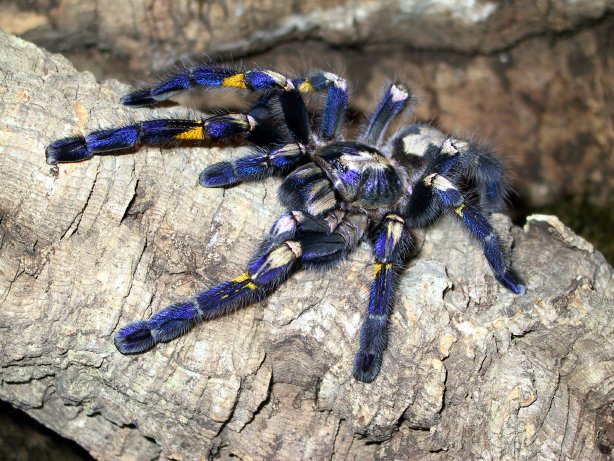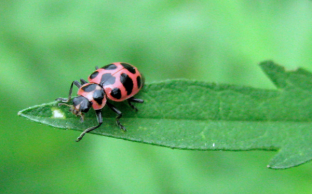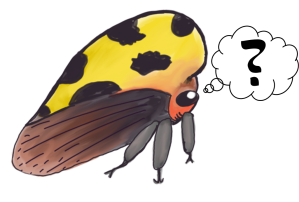One of the neat things about this project is that we get some questions that are asking about things in a very narrow sense, but hit on some really important and interesting topics which are very relevant in a broader sense. Take this question, for instance:
Your Name: Bev
Your Bug Question: Here’s a question I’ll bet you’ve never seen! I am interested in growing some Kermes oak (Quercus coccifera), in the hopes that I can introduce the kermes insect (such as kermes vermilio) to adopt it’s favorite host plant. I know I can purchase the oak to plant in my yard, but I’m wondering if there’s a way to find and purchase live bugs (or larvae, or eggs, or anything that will grow and live)? Help!
We did answer this question in private, and the short answer is that I don’t think they’re available for sale to the general public.
…but why is that?
Another person asked a very similar question over #BugQuestions on Twitter:
But seriously folks, we can buy ladybugs and praying mantis eggs, why can’t I buy a jar of fireflies? #bugquestions
— Victoria Bick (@VicBick) June 23, 2015
I think these two questions are really cool because they hit on a topic I honestly did not anticipate ever talking about when we started this blog. On the surface, they appear to be asking about acquiring specific insects…but in reality they’re talking about economics.
You can buy insects online, but the kinds of insects which are available fit some very specific criteria.
So what decides whether certain insects are sold online?
Legality

Leaf insects are really cool, but they’re not the sort of thing you can own outside of a quarantine facility. If you see pictures of us with these sorts of bugs, they’re usually taken at these facilities.
Image credit: Nancy Miorelli
This is the big one I’m putting up front and center. Some insects are illegal to keep, and we’re not going to help you get ahold of those. Sorry, but ethically we can’t do that.
Awhile back, Nancy wrote a post about which insects can go on planes and she discussed the reasons some insects aren’t allowed in the US there. Some insects, even very pretty ones, are potential pests and they’re very tightly controlled. You need special facilities to have them, and you aren’t going to be able to acquire them if you don’t have these facilities.
Yes, some people skirt the law. We know this happens. We don’t approve of that. We won’t help you find those people.
There are a lot of legal reasons insects can’t be brought into the US, but even transporting insects across state lines is not legal in many cases. The Gold Spotted Oak Borer, a beetle decimating oak trees in California, is extremely rare in it’s native range. However, when it was brought into California it became an extremely damaging pest.
Not only are there laws about what can be brought into the country, but there are also laws about what can be shipped over state lines. Anything shipped within the US has to conform to those laws, and that is very a very important consideration for people who sell insects online.
The Perception of Usefulness

Orius, a very small and very important biological control agent of thrips. This is the sort of thing you can buy online…if you like small bugs that eat thrips. Image credit: Boris Loboda License info: CC BY-NC-ND 2.0
A lot of commercial insectaries sell insects meant for use in agricultural biological control programs. These guys are meant to be an alternative to pesticides, but they’re not always as useful as advertised.
One example of such an insect is Orius insidiosus, which is a predator which eats thrips in some crops. They’re an important part of the environment, and many pesticides kill Orius better than they kill thrips. So farmers have to carefully select which pesticides they use, and buy predators to augment the Orius populations on their farms.
Orius is a very useful insect, but some insects sold for these reasons aren’t really useful. So perception is the key word here.
The most commonly bought and shipped biological control agents, Harmonia and Coccinella ladybirds, are well known for not being effective against the aphid pests they’re supposed to control. They’re caught after hibernation, and disperse as soon as they warm up. So they don’t really do much to help farmers.
There are other, potentially better, ladybirds which could be used for controls…and we’ll be discussing those at the bottom of the article.
Desirability
There are certain insects people like to keep around. Some of these insects, like silkworms have useful traits, but others are just really pretty.

Poecilotheria metallica, a very beautiful spider native to India. It’s very pretty, but has quite a bite. Image credit: Søren Rafn, via Wikimedia commons. License info: CC BY-SA 3.0
People like stick insects because they look cool. They also like predators, like scorpions, centipedes, and tarantulas. Big detritovores, like cockroaches, and millipedes are also popular. This is in the eye of the beholder, and what’s interesting to me might not be interesting to anyone else.
Tarantulas are the most commonly kept in the pet trade because they’re often very large, and very pretty…even if some species do bite.
Economics-supply, demand, and the costs of production.
Here’s where we get into the stuff I find the most interesting. The last few posts deal with the demand aspect, what makes people want to own various arthropods.
However, there’s also the supply angle to consider.
Let’s take the ladybird example. Harmonia and Coccinella are the cheapest insects to procure. They overwinter in huge aggregations, can be collected in large numbers with a shovel, and can be kept cool until it’s time to ship them out. There’s little cost to procure them, and almost no cost to maintain them.
However, they’re terrible biocontrol agents. They’re not effective and they’re highly invasive. Releases don’t always result in pest control, and they’re thought to contribute to the decline of native ladybird species.
They’re still sold because many people believe them to be effective, and they’re percieved to be useful despite the fact they’re not actually useful.

Coleomegilla maculata is a very important, if underutilized, biocontrol agent. It’s a textbook example of why economics makes biological control very difficult. Image credit: Kurt Faler, via flikr License info: CC BY-NC-ND 2.0
Rearing another species which eats both aphids and insect eggs, like Coleomegilla maculata, would be far more preferable. However, the cost of production would be much higher. Ladybirds are basically a fungible* commodity in the eyes of consumers, so bringing a more effective species to market has been difficult because of the higher cost.
That’s also the situation with mantids. People like mantids, and they’re percieved to be useful biocontrol agents. However, they’re not really useful when compared to things like Trichogramma wasps or Orius.
Why can’t you buy a jar of fireflies?
The firefly question, to me, is particularly interesting because it combines elements of the two. There are issues with both supply and demand.
Supply

Pyrocoelia are fireflies which have been investigated as potential biological control agents of invasive land snails. Aquatic species have been considered for control of aquatic snails. Image credit: 威翰 陳 License info: CC BY-NC-ND 2.0
Fireflies are extremely difficult to rear. They have very specific habitat requirements, and very specific diet requirements. A lot of time and effort goes into maintaining them. Insect rearing can be extremely difficult, but fireflies are actually a the perfect example for this post because their care requirements are simple enough for us to do some back-of-the envelope calculations.
Many species need snails to eat, and they need moist environments. The diet is hard to procure, and you’d need a lot of cage maintenance to prevent stuff from molding over.
The numbers below are for the species Pyrocoelia pectoralis, which is a small Chinese species with a simple rearing protocol. Acquatic species, like many of our native fireflies, would be a lot more complicated to rear and a lot more expensive.
From a labor perspective, it would make sense for you to maximize the effort you put into producing the product you sell. Your time is valuable, so you don’t want to spend more time than you would need to produce the food for your animals. So if I were doing this, I would use store-bought escargot to feed them. You’re looking at $12 for 100 larvae just for food, based off how much snail these guys would consume…and these numbers are in the published literature.
Substrate and hides to reduce cannibalism will probably run you about $20, but if you’re good with sterilizing stuff…that’s a one-time cost. Climate control is what’s gonna kill your pocketbook: a used incubator like the one you find in University labs will set you back about $3,000. Using heat lights to keep them at the proper temperature will be a lot less reliable, but also a lot less expensive. A 10 gallon terrarium is the cheapest tank you’ll be able to buy, and that’s about $30 at your local pet store. I’d imagine about $50 or so for a single-tank startup cost…plus maintenance.
Food is the most constant cost, but you’re also going to need supplies and power bills. You also want to make enough to make a living, and cover shipping costs and the occasional dead-on-arrival shipment.
I don’t think $30 for 100 adults would be an unreasonable back-of-the-envelope starting price.
Demand
So now that you’ve got a supply of fireflies, the question is how you would market them to consumers. Fireflies would be a cool novelty gift, but they’d also be pretty expensive for an insect that would only live a few days to a few weeks as adults. The adults produce the most light, so I believe you’d mainly be selling the adults.
Perhaps some people would buy them, but you’d also have a lot of competition from glowsticks. They’re a lot cheaper and fulfill the same purpose of a novelty glowing thing.
So that’s why you can’t buy fireflies. They’re expensive and hard to raise, but you also have competition from other forms of entertainment.
The Bottom Line
Working in industry has given me a new appreciation for economics, because I have to think about potential lines of research in economic terms. I have to think about what I can do ethically and legally, what my solutions would cost to produce, and what people will pay for them.
The pet trade is very much the same way. There are some pets that nobody should be able to own because they pose too much of a risk to human health or the environment. There are some things that only interest small amounts of people. There are some things that are too difficult or expensive to produce.
The same challenges which I work around in industry are also at play in the pet trade. There are a lot of things that would be cool to own, but would be economically unviable to produce for a profit.
Pet fireflies, unfortunately, are one of these things.
Works Cited
Fu, X., & Meyer-Rochow, V. B. (2013). Larvae of the firefly Pyrocoelia pectoralis (Coleoptera: Lampyridae) as possible biological agents to control the land snail Bradybaena ravida. Biological Control, 65(2), 176-183.
Koch, R. L. (2003). The multicolored Asian lady beetle, Harmonia axyridis: a review of its biology, uses in biological control, and non-target impacts. Journal of insect Science, 3(1), 32.
Obrycki, J. J., & Kring, T. J. (1998). Predaceous Coccinellidae in biological control. Annual review of entomology, 43(1), 295-321.
Reitz, S. R., Yearby, E. L., Funderburk, J. E., Stavisky, J., Momol, M. T., & Olson, S. M. (2003). Integrated management tactics for Frankliniella thrips (Thysanoptera: Thripidae) in field-grown pepper. Journal of economic entomology, 96(4), 1201-1214.
Van Lenteren, J. C. (2012). The state of commercial augmentative biological control: plenty of natural enemies, but a frustrating lack of uptake. BioControl, 57(1), 1-20.
*A Fungible commodity is one where any particular example of a product, like peanut butter, will stand in just as well as any other. Ladybird beetles are considered to be fungible because most people who buy them think there’s no real difference between species. A lot of people have tried to change this over the years, but the perception remains. Because the perception remains, the problem has gone unsolved.


A fascinating read!
LikeLike
I Think People Don’t Need To Buy Firefly Jars Because You Can Catch Them In Your Backyard🔥
LikeLike
Thank you for taking time to make this post! I am doing research for an Advance Placement class and one of the criteria was to search cost of fauna and flora to create the “perfect ecosystem”. Now I know why it was so hard for me to find a price! ;p
LikeLike
It’s difficult to find a price for stuff that’s not for sale. However, you could calculate a cost of replacement like I did here.
Is it perfect? Absolutely not, but it’s a pretty good ballpark estimate. 🙂
LikeLike
Great, so selling fireflies is not illegal, but due to difficulty in rearing would seem expensive. Back to the original question, where can I buy fireflies?!
LikeLike
Glowsticks don’t fly! I’ll take a dozen!
LikeLike
Rearing ladybugs isn’t really that fun. It’s just a lot of smelly mould, poop, aphids, and habitat cleaning. It did solve my aphid problem though. In fact, I somehow overpopulated my area with ladybugs mostly of the two or seven spotted variety.
LikeLike
Well the biggest reason to b buy fireflies is that they are also a predator insect that feeds at night. They have been dramatically reduced in the environment.
LikeLike
I love fireflies
LikeLike